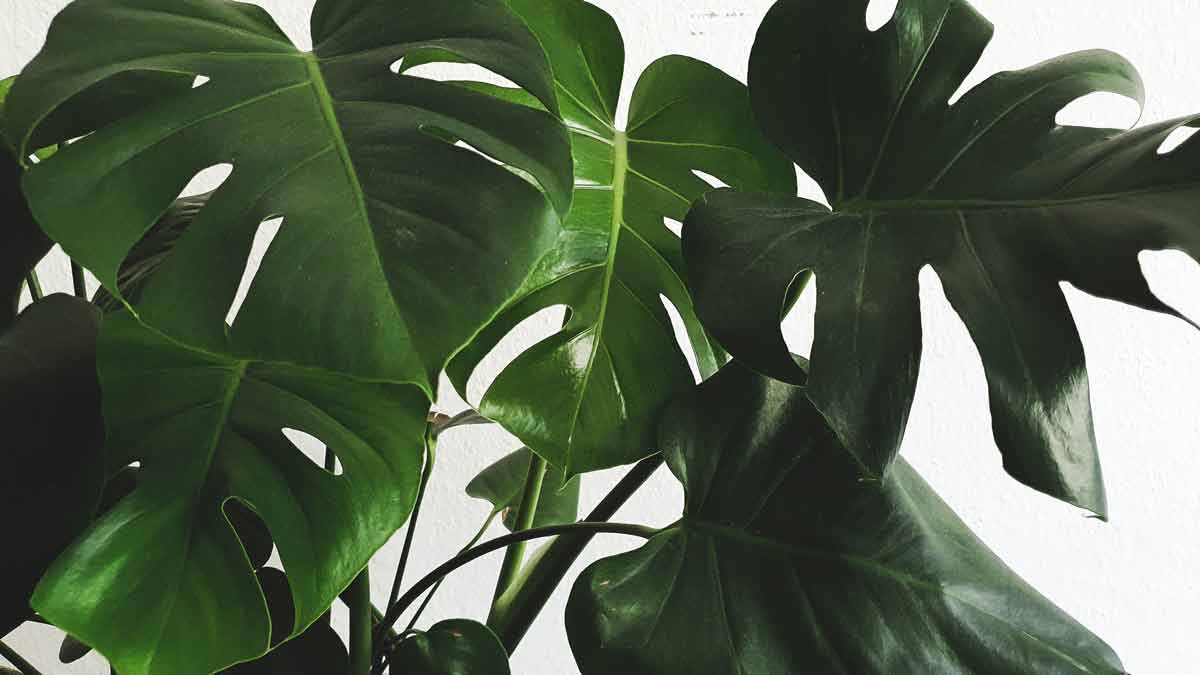To make a Monstera bushier, prune it in spring to limit the size and shape growth. Training by staking and bending stems can also promote lateral growth. Propagating by dividing stem cuttings can create multiple stems. Ensure proper light, water, and nutrients. To fix leggy growth, transfer to brighter light, prune, and propagate.
Are you a proud Monstera plant owner looking to enhance the beauty of your beloved plant? If yes, then you have come to the right place.
Monstera plants are known for their tropical aesthetic, and their lush green foliage can enhance any space.
However, if your Monstera, commonly known as de Swiss cheese plant, is starting to look leggy or sparse, it might be time to consider some techniques to promote bushiness.
Bushiness is important because it helps your Monstera look fuller and healthier.
By understanding Monstera growth patterns and following some simple tips and techniques, you can make your plant look more attractive than ever.
So, how can you make your Monstera bushier? Here we will explore some practical techniques that can help you achieve the desired results.
From pruning to propagation and adjusting environmental conditions, we will cover everything you need to know to make your Monstera plant thrive. So, let’s dive in and learn how to make your Monstera bushier!
Understanding Monstera Growth: Why Your Plant May be Leggy and Sparse
Monstera plants are a popular choice for indoor gardeners due to their tropical appearance and easy-to-care-for nature.
However, even the most experienced plant owners can face challenges when it comes to promoting bushiness in their Monstera plants.
Monstera plants are native to the tropical rainforests of Central and South America, where they grow as epiphytes on other trees.
In their natural habitat, Monstera plants have access to plenty of light, moisture, and nutrients, which allows them to grow to impressive heights of up to 60 feet.
However, when grown indoors, Monstera plants have limited access to these resources, which can affect their growth patterns.
Monstera plants naturally grow towards the light, which means that the stem will elongate to reach the light source.
If the illumination is insufficient or the plant is positioned too distant from the light source, the stem will persist in stretching, leading to a Monstera plant with a slender appearance and sparse foliage.
Another factor that can contribute to legginess in Monstera plants is the lack of lateral growth.
Monstera plants naturally produce aerial roots that can attach to other trees, allowing the plant to climb and produce more lateral growth.
However, when grown indoors, Monstera plants may not have access to other trees to climb, resulting in less lateral growth and a leggy appearance.
So, How to make a Monstera bushier?
Understanding Monstera growth patterns is key to promoting bushiness. In the next section, we will discuss some practical techniques for making your Monstera bushier.
Techniques for Making Your Monstera Bushier
Monstera plants are known for their unique appearance and are a favorite among plant lovers. However, achieving a bushy and healthy Monstera plant can be challenging.
Fortunately, there are several practical techniques for promoting bushiness in your Monstera plant.
Here we will discuss some effective techniques for making your Monstera bushier, including pruning, supporting, propagation, repotting, and adjusting environmental conditions.
Pruning
Pruning is an essential technique for promoting bushiness in your Monstera plant.
By cutting back the stem, you can stimulate new growth and encourage lateral growth, which will help fill out the plant and give it a bushier appearance.
Pruning also helps to remove any dead or damaged leaves and stems, which can improve the plant’s overall health.
When pruning your Monstera plant, be sure to use clean tools and make clean cuts. Dirty or dull tools can damage the plant, which can lead to disease or infection.
Use sharp pruning shears or scissors to make a clean cut just above a node or a Monstera leaf. This will encourage new growth to sprout from that location.
It’s best to prune your Monstera plant in the spring or summer when it’s actively growing.
You can also prune Monstera plants throughout the year as needed to remove dead or damaged leaves or stems.
Supporting Your Plant
Supporting your Monstera plant is another effective technique for promoting business.
By staking and training the stems, you can encourage lateral growth and prevent the plant from becoming leggy.
To stake your Monstera plant, insert a stake, moss pole, or trellis near the stem and gently tie the stem to the support. This will encourage the plant to grow towards the support, promoting lateral growth.
To train your Monstera plant, gently bend the stems to the side and secure them in place with plant ties or string. This will encourage the plant to grow more horizontally, which can help fill out the plant and give it a bushier appearance.
Propagation
Propagation is another great technique for making your Monstera plant bushier. By dividing stem cuttings or the root ball, you can stimulate new growth and create additional plants.
To propagate your Monstera plant from a cutting, start by selecting a healthy stem with at least two nodes. Cut the stem just below the lowest node and remove any leaves from the bottom of the stem.
Place the cutting in a jar of water or well-draining soil, and keep it in a warm, humid location. Within a few weeks, the cutting should begin to develop roots and new growth.
To split the Monstera root ball, gently remove the plant from its pot and separate the roots into smaller sections. Replant each section in its own pot with fresh soil and water thoroughly.
Repotting
Repotting is another technique for promoting bushiness in your Monstera plant.
By repotting the plant into a larger container with fresh soil, you can provide the plant with the nutrients and space it needs to grow and thrive.
It’s best to repot your Monstera plant in the spring or summer when it’s actively growing.
Choose a pot that is one size larger than the current pot and fill it with fresh, well-draining soil.
Gently remove the plant from its current pot and place it in the new pot. Fill in any gaps with additional soil and water thoroughly.
Adjusting Environmental Conditions
If you’ve tried all the above techniques and your Monstera still isn’t getting bushier, it might be time to adjust the environmental conditions in which it’s growing.
Several factors can impact the growth of your Monstera, including light, soil and pot selection, watering, fertilization, and humidity.
Light
Monstera plants prefer bright indirect light. If your Monstera isn’t getting enough sunlight, it can become leggy and sparse.
On the other hand, if it’s getting too much direct sunlight, the Monstera leaves can sunburn and become damaged.
To promote bushiness, make sure your Monstera is getting the right amount of light. If it’s not, you may need to move it to a different location.
When grown indoors, the best place for your Monstera is near an east- or west-facing window. This will provide it with the bright indirect light it needs.
Soil and Pot Selection
The soil and pot you use can also impact the growth of your Monstera.
Monstera plants prefer well-draining soil that’s rich in organic matter. You can also add perlite or vermiculite to the soil to help improve drainage.
When it comes to pot selection, make sure you choose a pot that’s large enough for the plant.
Monstera plants can quickly outgrow small pots, which can prevent them from getting bushier.
A pot with drainage holes is also essential for preventing root rot and other moisture-related issues.
Watering
Overwatering can lead to root rot, and underwatering can cause your Monstera to become dehydrated and sparse.
To promote bushiness, make sure you’re watering your Monstera correctly.
Water it thoroughly and allow the soil to dry out slightly before watering it again.
When watering your Monstera, be sure to use lukewarm water. Cold water can shock the plant and cause leaves to drop.
Use a moisture meter to help you measure the soil’s moisture level. This will help ensure your Monstera is getting the right amount of water.
Fertilizer
Using a good fertilizer can also help promote bushiness in your Monstera plant.
Look for a balanced fertilizer with an equal ratio between nitrogen, phosphorus, and potassium (N-P-K).
Monstera plants need plenty of nitrogen for healthy growth, so be sure to choose a fertilizer with a higher concentration of this nutrient.
During the growing season (spring and summer), fertilize your Monstera every two weeks, and reduce the frequency to once a month in the fall and winter.
Humidity Control
Monstera plants prefer high humidity levels. If the air in your home is too dry, it can cause your Monstera to become dehydrated and sparse.
You can increase the humidity around your Monstera by using a humidifier or by placing a tray of water near the plant.
To promote business, monitor the humidity around your Monstera and adjust it accordingly.
The ideal relative humidity for a Monstera plant is between 50-70%. Keep an eye on your plant’s leaves. If they appear dry or wilted, it’s time to increase the humidity.
With careful care and attention, you can make your Monstera plant bushier and healthier.
Following these tips and tricks will help you keep your Monstera looking beautiful all year long.
If you have any additional questions, consult with a professional horticulturist or garden center for more expert advice on how to make your Monstera bushier. Good luck!
Final Thoughts
There are several ways to make a Monstera bushier, such as pruning, training, and propagating.
Pruning can be done in the spring, just before the growing season, to limit the plant’s size and influence the shape of its growth. This will help the plant to grow fuller and bushier by ensuring that it has more energy and resources to direct towards the remaining branches and leaves.
Training the plant by staking it and gently bending the stems to promote lateral growth can also encourage bushier growth.
Propagating Monstera plants by dividing stem cuttings or the root ball can help to create multiple stems in the same pot, leading to a bushier appearance.
Providing enough sunlight, water, and nutrients is also essential for promoting healthy growth and business.
If a Monstera plant becomes leggy, transferring it to a spot with brighter, indirect natural light and pruning and propagating can help to fix the issue.
With proper care, you can make your Monstera plant bushier and healthier in no time.







